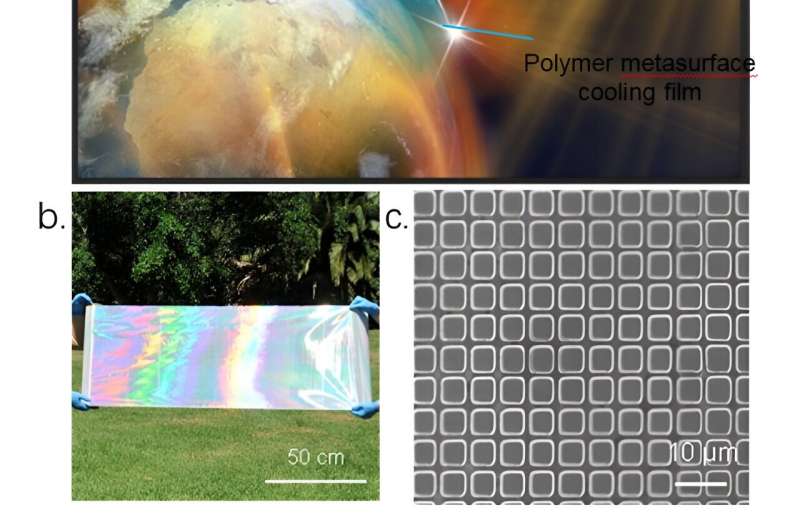This article has been reviewed according to Science X's editorial process and policies. Editors have highlighted the following attributes while ensuring the content's credibility:
fact-checked
peer-reviewed publication
proofread
Scientists develop a roll-to-roll polymer film for improved radiative cooling

Domestic and industrial thermal management accounts for a significant portion of global energy consumption. Effectively maintaining a desired temperature with minimum energy input is critical from both economic and environmental points of view. Indoor thermal management is usually achieved by air conditioning (AC), which consumes a huge amount of energy.
By 2023, the world's annual AC energy consumption is expected to exceed hundreds of billions of dollars. This sum will be worsened by the continuous cooling requirements (24/7) from an increasing number of large data centers. Due to the severe economic burden and deteriorated environment, there is an urgent need for renewable cooling techniques with minimum energy input.
In a new paper published in eLight, a team of scientists led by Professor Baohua Jia of RMIT University in Melbourne have developed a roll-to-roll polymer film for improved radiative cooling. The novel technique is a metasurface concept enabled by arranging 3D trench-like structures within the thin layer of the polymer film.
Conventional heat dissipation usually requires extra energy consumption. Radiative cooling technology has attracted widespread attention due to its unique capability of emitting thermal radiation into outer space. This cools an object while consuming no energy. An ideal radiative cooler should have high emissivity within the Earth's atmospheric transparency window. The radiative coolers should strongly reflect solar irradiation to prevent being heated up by sunlight. Therefore, the ability to flexibly and accurately manipulate spectra in a large range holds the key to achieving high cooling performance, but this remains a challenge.
Radiative cooling effects have been successfully demonstrated in three distinct types. The types are based on materials used and structural engineering strategies: polymers, multilayer thin films, and metamaterials. Among these designs, polymer films have shown many attractive features. They include low solar absorption, relatively high emissivity in the atmospheric transparency windows, low cost, and scalability, which make them very promising for real-life applications.
However, films that are only based on the intrinsic material absorption properties without nanostructural engineering, have only a limited ability to achieve unity IR emissivity and solar reflectance at desired broad bandwidth. Although embedding randomly distributed particles can improve spectral controllability, achieving a precisely controlled spectrum is challenging.
Metamaterials based on periodic structures have demonstrated outstanding spectral manipulation capability for diurnal radiative cooling. But metamaterial radiative coolers are based on rigid substrates with large thicknesses, which cannot be integrated with objects with arbitrary shapes. More importantly, due to the fabrication challenges of the periodic micro/nanostructures, they are limited to small areas and, therefore, are not suitable for real-life applications.
The research team enabled precise spectrum manipulation capability in thin polymer materials by designing periodic trench-like metasurface structures. They then fabricated them using a manufacturing-friendly roll-to-roll printing technique. The 50-μm-thick polymer metasurface radiative cooling (PMRC) film reflects almost all the incident sunlight. At the same time, it strongly emits thermal radiation in the atmospheric transparency windows. This results in an outstanding cooling performance all day.
The film can be integrated easily into various devices, such as a water tank, a COVID protective suit, and a car cover, achieving excellent cooling performance. The large-scale roll-to-roll fabricated flexible PMRC film is cost-effective and readily attachable to any object for broad cooling applications, meeting stringent cooling needs without energy consumption. The PMRC film presents omnidirectional absorption and emission while offering superior cooling performance. It also provides flexibility, scalability, and good stability, promising enormous practical applications in thermal management.
More information: Keng-Te Lin et al, Highly efficient flexible structured metasurface by roll-to-roll printing for diurnal radiative cooling, eLight (2023). DOI: 10.1186/s43593-023-00053-3

















